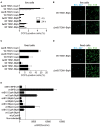BtpB, a novel Brucella TIR-containing effector protein with immune modulatory functions
- PMID: 23847770
- PMCID: PMC3703528
- DOI: 10.3389/fcimb.2013.00028
BtpB, a novel Brucella TIR-containing effector protein with immune modulatory functions
Abstract
Several bacterial pathogens have TIR domain-containing proteins that contribute to their pathogenesis. We identified a second TIR-containing protein in Brucella spp. that we have designated BtpB. We show it is a potent inhibitor of TLR signaling, probably via MyD88. BtpB is a novel Brucella effector that is translocated into host cells and interferes with activation of dendritic cells. In vivo mouse studies revealed that BtpB is contributing to virulence and control of local inflammatory responses with relevance in the establishment of chronic brucellosis. Together, our results show that BtpB is a novel Brucella effector that plays a major role in the modulation of host innate immune response during infection.
Keywords: Brucella; Btp1/BtpA; DC; NF-κB; TIR domain; TLR.
Figures






References
MeSH terms
Substances
LinkOut - more resources
Full Text Sources
Other Literature Sources
Molecular Biology Databases
Miscellaneous

